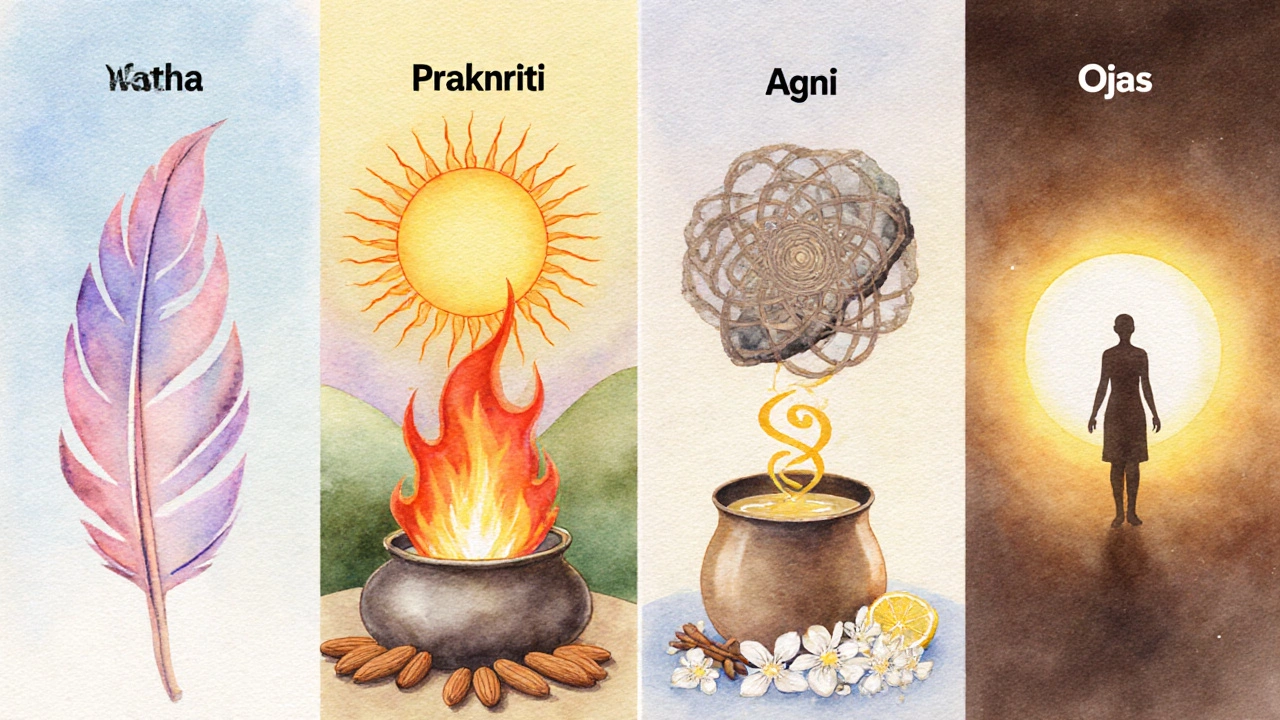4 Core Principles of Ayurveda Explained
 Oct, 24 2025
Oct, 24 2025
Ayurvedic Dosha Assessment Quiz
Discover Your Ayurvedic Constitution
10 QuestionsThis quick assessment helps identify your dominant dosha based on Ayurvedic principles. Your results will show which dosha is most prominent and provide personalized lifestyle recommendations.
Your Ayurvedic Constitution
Personalized Recommendations
-
Food Focus:
-
Best Sleep Time:
-
Key Practice:
When people talk about Ayurveda is an ancient Indian system of holistic medicine that balances body, mind, and spirit, they usually point to four guiding ideas that keep everything in sync. These ideas aren’t just philosophy - they’re practical tools you can use every day to feel steadier, sleep better, and digest food more easily. Below we break down each principle, show how they link together, and give easy steps to bring them into your routine.
1. The Concept of Dosha - Your Body’s Blueprint
Ayurveda starts with the belief that every person is a unique combination of three Dosha (Vata, Pitta, and Kapha). Think of doshas as energetic fingerprints - they dictate how you move, think, and react to the world. Vata is light and airy, governing motion and creativity; Pitta is fiery, driving metabolism and ambition; Kapha is earthy, providing structure and calm.
- Vata: dry skin, quick thoughts, irregular sleep.
- Pitta: strong appetite, sharp focus, tendency toward irritability when overheated.
- Kapha: sturdy build, steady mood, slower digestion.
Identifying your dominant dosha (or dosha mix) is the first step toward applying the other three principles effectively. Online quizzes can give a rough idea, but a qualified Ayurvedic practitioner can fine‑tune the assessment by checking pulse, tongue, and bowel habits.
2. Prakriti - Your Innate Constitution
Prakriti (the inherent nature you are born with) is the static side of your dosha makeup. While doshas can shift due to diet, stress, or climate, prakriti stays constant - it’s the baseline you return to when you’re balanced.
Knowing your prakriti helps you tailor diet, exercise, and sleep patterns. For example, a Vata‑dominant prakriti thrives on warm, grounding foods and regular routines, whereas a Pitta‑dominant prakriti feels best with cooling meals and mindful breaks.
Practical tip: Keep a simple diary for one week noting meals, mood, and energy levels. After the week, see which dosha traits appear most often - that’s likely your prakriti.
3. Agni - The Digestive Fire
In Ayurvedic language, Agni (the metabolic fire that transforms food into energy) is the engine that fuels every cell. When agni is strong, nutrients are absorbed efficiently and waste is eliminated smoothly. When it’s weak or erratic, you might experience bloating, fatigue, or skin issues.
Three states of agni are commonly described:
- Sama Agni - balanced, steady digestion.
- Visha Agni - toxic, leading to cravings and sluggishness.
- Vishama Agni - irregular, causing alternating constipation and diarrhea.
Simple ways to support agni include drinking warm water with lemon each morning, chewing food thoroughly, and avoiding over‑indulgence in raw, cold foods if you’re a Vata type.

4. Ojas - The Essence of Vitality
Lastly, Ojas (the subtle energy that sustains immunity, stamina, and mental clarity) is what remains when agni flawlessly converts food into nourishment. Ojas is the glue that holds body, mind, and spirit together; low ojas often shows up as chronic fatigue, anxiety, or a weakened immune response.
Building ojas is all about consistency: sleep 7‑9 hours, practice gentle yoga or meditation, and consume nutrient‑dense, sattvic foods like almonds, ghee, and fresh fruit. Avoid excessive caffeine, alcohol, or processed sugars, as they burn through ojas quickly.
How the Four Principles Interact
Think of the four principles as a loop:
- Dosha tells you which foods and habits will naturally support you.
- Prakriti gives you the static template you aim to return to.
- Agni processes the food you choose based on your dosha.
- Ojas is the end product of a well‑functioning agni.
When any link in the chain breaks - say, a weak agni due to erratic meals - ojas suffers, and you feel out of sync with your dosha. Restoring balance means tweaking the earlier steps.
Quick Reference Table
| Principle | Sanskrit Name | Main Focus | Everyday Action |
|---|---|---|---|
| Dosha | Dosha | Identify energetic constitution | Take a short quiz, note dominant traits |
| Prakriti | Prakriti | Understand innate baseline | Keep a week‑long diary of meals and moods |
| Agni | Agni | Maintain strong digestive fire | Warm lemon water each morning, chew well |
| Ojas | Ojas | Build vitality and immunity | Sleep 7‑9 hrs, practice meditation, eat sattvic foods |

Common Pitfalls and How to Avoid Them
Even with a clear roadmap, many beginners trip up. Here are three frequent mistakes and quick fixes:
- Jumping to diet changes without dosha awareness. Solution: Start with a dosha assessment, then pick foods that naturally calm your dominant element.
- Skipping meals or eating late at night. Solution: Keep a regular schedule; aim for dinner before 7 p.m. to protect agni.
- Over‑stimulating the mind with screens. Solution: End the day with 15 minutes of gentle breathing or a short walk to preserve ojas.
Bringing the Principles Into a Busy Life
Living in Birmingham, you might think you don’t have time for a full Ayurvedic routine. The good news is that the four principles translate into tiny habits:
- Morning: Warm water with a pinch of ginger (supports agni).
- Mid‑day: Choose a balanced plate - a portion of whole grains, a serving of cooked veg, and a protein that matches your dosha (e.g., lentils for Vata, turkey for Pitta).
- Evening: Finish food at least three hours before bed, then wind down with a short meditation (boosts ojas).
These three touch‑points respect all four principles without demanding a lifestyle overhaul.

When to Seek Professional Guidance
If you notice chronic fatigue, digestive distress, or frequent mood swings despite following the basics, a trained Ayurvedic practitioner can dig deeper. They may recommend Panchakarma (a detoxifying suite of therapies tailored to dosha imbalance), specific herbal formulas, or personalized yoga sequences.
Remember, Ayurveda complements modern medicine - it’s not a substitute for prescription drugs or doctor visits when serious conditions arise.
Recap: Your 4‑Step Ayurvedic Check‑In
- Identify your Dosha blend.
- Confirm your Prakriti to know your baseline.
- Support Agni with warm, mindful eating.
- Nurture Ojas through rest, meditation, and sattvic foods.
Follow this loop each day and you’ll notice steadier energy, clearer skin, and a calmer mind - all hallmarks of a balanced Ayurvedic life.
Frequently Asked Questions
What is the difference between Dosha and Prakriti?
Dosha describes the dynamic energy patterns that can shift with lifestyle, while Prakriti is the static, innate constitution you are born with. Think of Dosha as the weather and Prakriti as the climate.
How can I tell if my Agni is weak?
Common signs of weak Agni include frequent bloating, feeling heavy after meals, cravings for sweet or salty foods, and occasional nausea. Improving meal timing and adding ginger or cumin to dishes can help reignite the fire.
Can I have more than one dominant Dosha?
Yes. Most people are a blend of two Doshas (e.g., Vata‑Pitta) with a third in the background. Your diet and routine should aim to balance the two primary elements while keeping the third supportive.
Is Ojas the same as immunity?
Ojas is broader - it covers immunity, stamina, mental clarity, and emotional resilience. Strong ojas usually means a robust immune system, but it also reflects overall vitality.
Do I need expensive herbs to follow Ayurveda?
Not at all. The core principles rely mostly on everyday foods, routine, and simple lifestyle tweaks. Herbs become useful for specific imbalances, but you can start with basics like turmeric, ginger, and fenugreek, which are inexpensive.